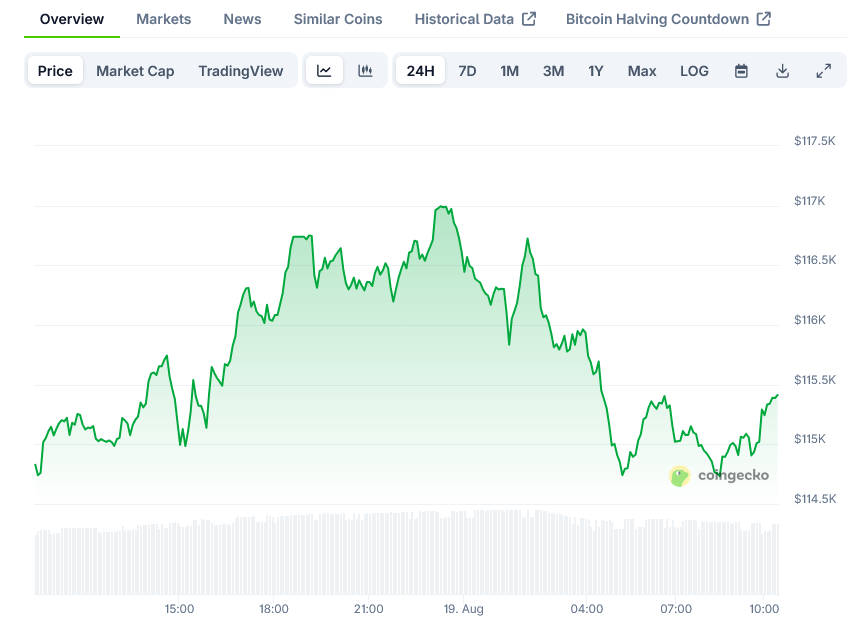TLDR
- Bitcoin experienced a 1.9% dip to $114,707 following $3 billion in realized gains on August 16
- On-chain data shows $116,963 is Bitcoin’s largest cost-basis cluster (3.61% of supply)
- Bitcoin’s Accumulation Trend Score dropped from 0.57 to 0.20, showing reduced buying interest
- Fed rate cut expectations for September decreased from 80% to 73%
- Some analysts believe Bitcoin won’t be fully “priced in” until Trump announces Jerome Powell’s replacement as Fed Chair
Bitcoin has pulled back from its all-time high as profit-taking and decreased buying pressure have impacted the market. The cryptocurrency reached a record high of $124,128 on Wednesday before dropping approximately 6% to around $115,150.
On August 16, the market saw over $3 billion in realized gains, triggering the largest profit-taking spike of the month. This selling pressure pushed Bitcoin down by 1.9% to $114,707, starting the week in negative territory.

The current price action suggests Bitcoin may be heading toward a retest of the $110,000 level. While the recent all-time high was just achieved, on-chain data indicates the current support might not be strong enough to prevent further decline.
According to Glassnode data, the $116,963 price point represents Bitcoin’s largest cost-basis cluster, containing over 700,000 BTC (3.61% of the total supply). This significant concentration makes it both a potential resistance level and a trigger point for a deeper pullback.
The $114,000 level may attract some buyers, but with such a large supply cluster near breakeven, there’s an increased risk of a margin squeeze. This makes $110,000 appear to be a more likely target for a liquidity grab before fresh buying interest emerges.
Declining Accumulation Interest
Bitcoin’s Accumulation Trend Score has recently declined, dropping from 0.57 to 0.20 in less than a week. This metric turned orange for the first time this month, highlighting a clear reduction in HODLer accumulation activity, even at lower prices.
The market has become increasingly ask-heavy, with supply dominating the price action. This imbalance between buyers and sellers has contributed to Bitcoin’s nearly 8% retreat from its all-time high.
The weakening bid-side support creates conditions that could lead to liquidity hunting at lower price levels. This technical setup aligns with the potential for a $110,000 retest or possibly lower before FOMO (Fear Of Missing Out) returns to drive the next leg up.
Federal Reserve Influence
Macro factors are also playing a role in Bitcoin’s price movement. On Polymarket, the odds for a 25 basis point rate cut on September 25 have decreased from over 80% to 73%, while the probability of no change increased from 12% to 26% in just one week.
This shift in rate cut expectations has dampened some of the optimism that was fueling Bitcoin’s rally. The market had been pricing in a fourth-quarter rally based on anticipated monetary easing, but as this catalyst becomes less certain, FOMO has temporarily subsided.
According to the CME FedWatch Tool, 83.9% of market participants still expect a rate cut at the Fed’s September 17 meeting. However, the reduced consensus has impacted risk appetite in the cryptocurrency market.
Some economists, including Alex Krüger, believe that Bitcoin’s current price doesn’t fully account for a potentially more dovish Federal Reserve policy. Krüger suggests that Bitcoin won’t be fully “priced in” until President Trump announces his nominee to replace Jerome Powell as Fed Chair.
Trump’s relationship with Powell has been tense since his inauguration in January, with the president frequently criticizing the Fed’s reluctance to cut rates. Powell’s term expires in May 2026, but reports indicate Trump may announce a replacement sooner than expected.
The Trump administration is reportedly considering 11 candidates for the position, including Jefferies’ chief market strategist David Zervos, BlackRock’s global fixed income chief investment officer Rick Rieder, and former Fed Governor Larry Lindsey.
Bitcoin currently trades at approximately $115,331, representing a pullback of about 7% from its recent all-time high. The cryptocurrency market continues to watch for signs of institutional buying at these levels and remains sensitive to developments in monetary policy.





